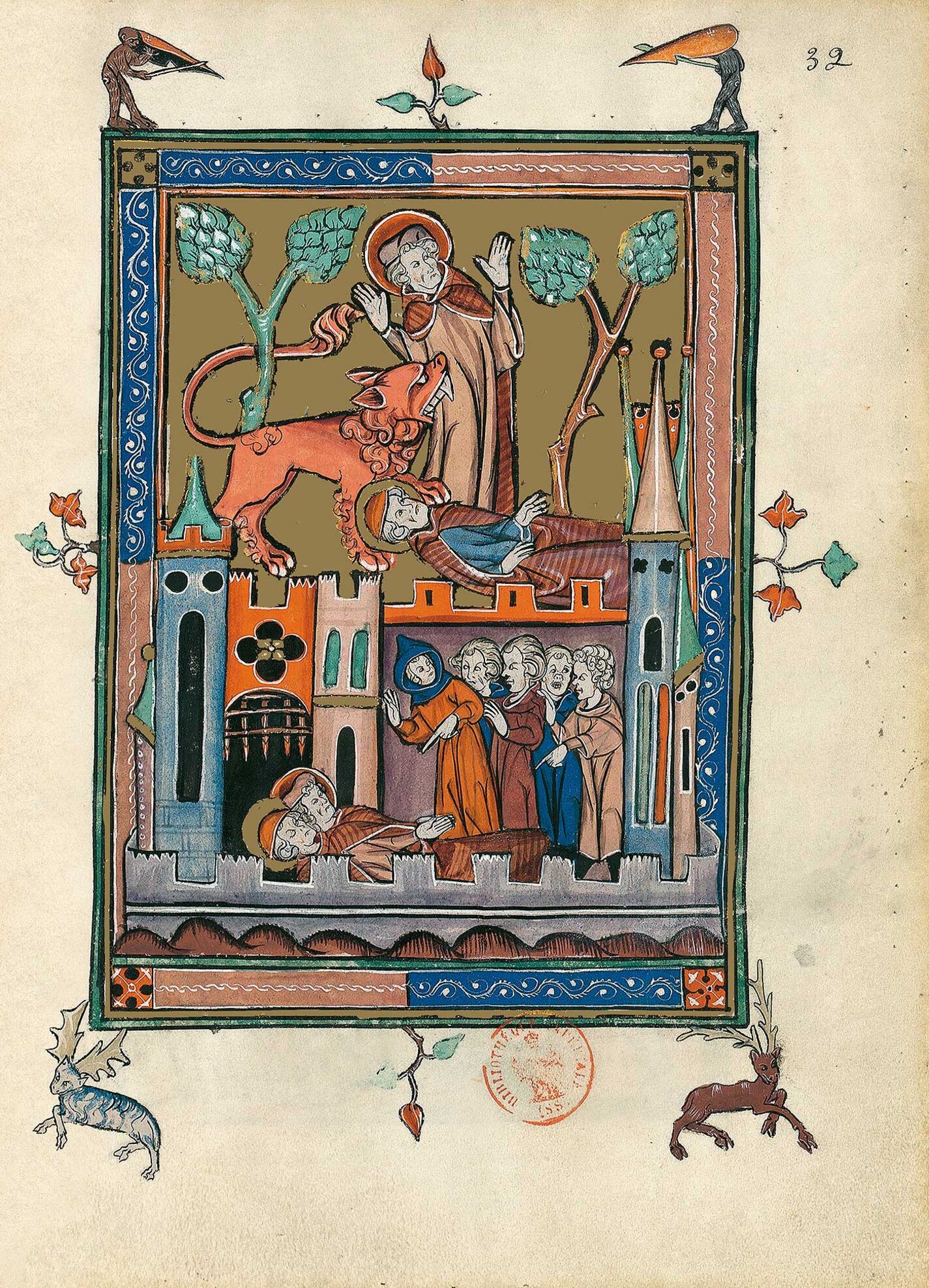John (f. 31v) puts his vision down in writing whilst the vision itself (f. 32) is portrayed in a composition in which the chronological layout of the narrative takes priority over spatial coherence. The image reads from top to bottom, and the two episodes it features are joined by the crenellated walls surrounding the great city, doted with towers and a gate with the portcullis hoisted.
After wandering through this city testifying to Christ for one thousand two hundred and sixty days, Elias and Enoch are attacked by the Beast from the Abyss. A lion beats the nearby trees with its tail in anger. It poses a powerful paw on one of the witnesses already on the ground whilst biting the other witness on the hip, unbalancing him to knock him to the floor more easily. Thus the Beast, said by the commentator to represent the Antichrist, kills the two prophets. Their bodies lie in the square of the city of “Sodom or Egypt as it is known symbolically, where the Lord was crucified too”. This means Jerusalem, but not the holy city but the city which, besieged by the forces of Evil, “killest the prophets and stonest them that are sent unto thee” (Matt. 23: 37-39 and Lk. 13: 34-35). No longer subject to the accusations of God’s messengers and their reproaches, the people gathered laugh and point at the two saints “exposed to the gaze of tribes, races, languages and nations for three and a half days without being allowed to be entombed”. But beneath the ramparts, the rippling earth announces an impending catastrophe.
Marie-Thérèse Gousset and Marianne Besseyre
Illuminated Manuscripts Research Center, Bibliothèque nationale de France
Fragment of the Apocalypse of 1313 commentary volume

John (f. 31v) puts his vision down in writing whilst the vision itself (f. 32) is portrayed in a composition in which the chronological layout of the narrative takes priority over spatial coherence. The image reads from top to bottom, and the two episodes it features are joined by the crenellated walls surrounding the great city, doted with towers and a gate with the portcullis hoisted.
After wandering through this city testifying to Christ for one thousand two hundred and sixty days, Elias and Enoch are attacked by the Beast from the Abyss. A lion beats the nearby trees with its tail in anger. It poses a powerful paw on one of the witnesses already on the ground whilst biting the other witness on the hip, unbalancing him to knock him to the floor more easily. Thus the Beast, said by the commentator to represent the Antichrist, kills the two prophets. Their bodies lie in the square of the city of “Sodom or Egypt as it is known symbolically, where the Lord was crucified too”. This means Jerusalem, but not the holy city but the city which, besieged by the forces of Evil, “killest the prophets and stonest them that are sent unto thee” (Matt. 23: 37-39 and Lk. 13: 34-35). No longer subject to the accusations of God’s messengers and their reproaches, the people gathered laugh and point at the two saints “exposed to the gaze of tribes, races, languages and nations for three and a half days without being allowed to be entombed”. But beneath the ramparts, the rippling earth announces an impending catastrophe.
Marie-Thérèse Gousset and Marianne Besseyre
Illuminated Manuscripts Research Center, Bibliothèque nationale de France
Fragment of the Apocalypse of 1313 commentary volume